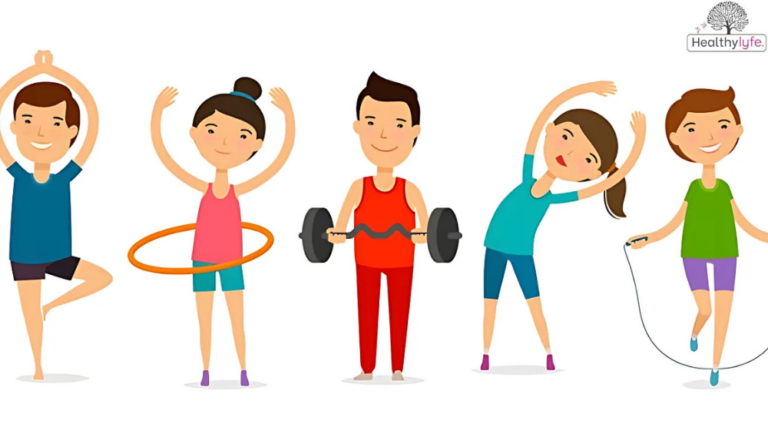Introduction
Physical fitness is more than just a buzzword in the world of health and wellness. It’s a lifestyle choice that impacts every facet of our lives. Whether you’re trying to get stronger, lose weight, or simply feel better, understanding the components of physical fitness is the first step in achieving your goals. Physical fitness isn’t just about aesthetics or lifting heavy weights in the gym—it’s about maintaining a body that functions optimally for both everyday activities and more strenuous tasks.
In this article, we’ll break down what physical fitness is, its key components, the benefits it offers, and how you can improve your fitness levels. We’ll also dive into the potential disadvantages and provide a balanced approach to incorporating fitness into your routine.
What Is Physical Fitness?
Physical fitness is the ability of your body to function effectively and efficiently in various aspects of daily life. This includes the ability to perform tasks that require strength, endurance, flexibility, and coordination. The primary goal of physical fitness is to improve the overall well-being of the individual by enhancing their physical health and mental state.

When your body is fit, it can handle stress more easily, resist illness, and maintain a higher quality of life. Physical fitness is not a one-size-fits-all approach—it can vary depending on individual goals, whether that’s weight loss, muscle gain, or improved heart health.
The Importance of Physical Fitness
In today’s sedentary world, staying physically fit is crucial for combating lifestyle-related diseases such as obesity, diabetes, and heart disease. Regular physical activity strengthens your muscles and bones, improves cardiovascular health, enhances flexibility, and boosts your immune system. Beyond these physical benefits, fitness also plays a significant role in mental and emotional health, helping to alleviate stress, reduce anxiety, and improve overall mood.
Why Should We Focus on Physical Fitness?
The modern lifestyle has shifted towards less movement and more desk jobs, driving up health issues. Making physical fitness a priority can prevent chronic illnesses, improve mental clarity, and boost your energy. Even more importantly, regular exercise can extend your lifespan and improve the quality of your life, allowing you to age gracefully.
Components of Physical Fitness [1]
Physical fitness is a multi-dimensional concept that includes several distinct components. Each one plays a crucial role in maintaining a healthy and well-functioning body. Below, we will explore the six major components of physical fitness and their significance.
Cardiovascular Endurance
Cardiovascular endurance refers to the ability of your heart and lungs to supply oxygen to the muscles during sustained physical activity. It’s what enables you to run for miles, cycle for hours, or swim continuous laps without getting winded.
How Cardiovascular Endurance Affects Your Health
Building cardiovascular endurance improves the efficiency of your cardiovascular system (your heart and blood vessels). This type of endurance is key in preventing cardiovascular diseases, reducing high blood pressure, and boosting energy levels. By improving cardiovascular endurance, you increase your body’s ability to perform activities without feeling fatigued, which also contributes to weight management and overall health.
Muscular Strength
Muscular strength is defined as the maximum amount of force a muscle or group of muscles can generate. It’s what helps you lift heavy objects, push, pull, or carry things without straining yourself.
Why Muscular Strength Matters
Muscular strength is important because it plays a major role in performing everyday tasks like carrying groceries or lifting boxes. Strong muscles protect your bones and joints from injury and contribute to better posture, which reduces the risk of back pain. Muscular strength also supports athletic performance, enabling you to jump higher, run faster, and move more efficiently.
Muscular Endurance
While muscular strength focuses on how much weight you can lift at one time, muscular endurance focuses on how long your muscles can sustain activity. It refers to the ability of your muscles to perform repeated contractions over a prolonged period.
Building Muscular Endurance for Daily Life
Improving muscular endurance allows you to engage in long-duration activities like running, swimming, or hiking without becoming overly fatigued. It’s particularly important for athletes who need to perform for extended periods, but it also helps with daily tasks like climbing stairs or carrying a heavy bag for an extended time.
Flexibility
Flexibility refers to the range of motion of your joints and muscles. It’s how easily your body can stretch, bend, and twist without discomfort.
The Role of Flexibility in Injury Prevention
Flexibility plays a crucial role in preventing injuries. When you have flexible muscles and joints, you’re less likely to strain or tear them during physical activity. Regular stretching also enhances circulation and promotes relaxation, helping muscles recover more quickly after exercise. Additionally, increased flexibility can improve posture and reduce tension, which may alleviate back and neck pain.
Body Composition
Body composition is a measurement of the proportion of fat, muscle, bone, and other tissues that make up your body. It’s different from weight, as it provides a more accurate representation of body health by focusing on the ratio of fat to lean mass.
Understanding Body Fat Percentage
Having a healthy body fat percentage is essential for optimal health. High levels of body fat, especially visceral fat (fat stored around organs), can increase the risk of cardiovascular diseases, diabetes, and other chronic health issues. Reducing body fat while increasing muscle mass improves your body’s metabolism and can enhance overall physical performance.
Balance and Coordination
Balance is the ability to maintain control of your body’s position, either when stationary or in motion. Coordination refers to the ability of your brain and muscles to work together to perform smooth, controlled movements.
Why Balance and Coordination are Vital for Performance
Good balance and coordination are necessary for avoiding falls and injuries, especially as we age. In sports, they help with movements like running, swimming, and dancing. Improving your balance and coordination ensures more fluid movement and allows for better control over your body, leading to enhanced performance during both exercise and daily activities.
Benefits of Physical Fitness
Achieving physical fitness isn’t just about aesthetics or being able to lift heavy weights. The benefits of regular physical activity extend far beyond physical appearance, improving nearly every aspect of your health.
Physical Benefits

The physical benefits of fitness are numerous. They include:
- Improved cardiovascular health: Regular exercise reduces your risk of heart disease, stroke, and hypertension.
- Increased muscle mass: Strength training promotes muscle growth, helping to increase strength and reduce fat.
- Better bone health: Weight-bearing exercises like walking, running, and strength training help increase bone density, reducing the risk of osteoporosis.
- Improved immune function: Regular physical activity helps strengthen the immune system and fight off infections.
- Improved metabolic health: Fitness supports healthier cholesterol and blood sugar levels, lowering the risk of diabetes.
Mental Benefits
Exercise is known to stimulate the release of endorphins, often referred to as “feel-good hormones,” which help reduce stress, anxiety, and depression. Additionally, exercise has been linked to improved cognitive function, including memory, focus, and mental clarity. Regular physical activity can boost self-esteem and improve overall mood, giving you a more positive outlook on life.
Emotional Benefits
Regular fitness routines can boost your mood by reducing stress and anxiety. Exercise provides an opportunity for mental relaxation and focus, offering a healthy outlet for negative emotions. The sense of accomplishment from achieving fitness goals also contributes to improved self-confidence and a more positive self-image.
Disadvantages of Physical Fitness
While the benefits of physical fitness are abundant, it’s important to recognize that there are potential downsides if not approached carefully.
Overtraining and Injury Risks
Overtraining is one of the most common issues among those who exercise intensely. Pushing your body too hard without allowing sufficient rest can lead to fatigue, burnout, and even injury. It’s important to give your muscles time to recover and avoid pushing beyond your limits.
Potential Negative Impact on Mental Health
For some, an overemphasis on fitness can lead to unhealthy body image issues or an obsession with exercise. Exercise addiction, eating disorders, and other mental health struggles can arise if physical fitness is pursued without a balanced perspective. It’s crucial to remember that fitness is about health, not perfection.
How to Improve Your Physical Fitness
Improving physical fitness requires a holistic approach that includes regular exercise, proper nutrition, and sufficient rest. Here are some tips for boosting your fitness:
Diet and Nutrition
Fueling your body with a balanced diet is essential for supporting fitness progress. A diet rich in lean proteins, healthy fats, and complex carbohydrates will provide the energy and nutrients your body needs to perform at its best.
Exercise Routines and Their Role in Fitness
Incorporate a mix of cardio, strength training, and flexibility exercises into your routine. Aim for at least 150 minutes of moderate-intensity aerobic activity per week, along with two or more days of strength training.
Rest and Recovery
Rest is just as important as exercise. Giving your body time to recover ensures that your muscles repair and grow. Get adequate sleep, incorporate rest days into your routine, and listen to your body when it needs a break.
Conclusion
Physical fitness is an essential part of living a healthy life. It’s not just about achieving a certain look—it’s about ensuring your body is capable of handling the demands of everyday life and maintaining long-term health. By focusing on all the components of physical fitness—cardiovascular endurance, muscular strength, flexibility, and more—you can significantly improve your quality of life. Remember, fitness is a lifelong journey, and the key to success is consistency, balance, and dedication.
FAQs About Physical Fitness
What are the 5 components of physical fitness?
The five components of physical fitness are:
Cardiovascular endurance: The ability of your heart and lungs to supply oxygen to muscles during prolonged activity.
Muscular strength: The maximum amount of force that a muscle or group of muscles can generate.
Muscular endurance: The ability of muscles to sustain repeated contractions or continuous exertion over time.
Flexibility: The range of motion around a joint, allowing for fluid and safe movement.
Body composition: The proportion of fat, muscle, bone, and other tissues that make up your body, usually measured as the ratio of lean mass to body fat.
How does physical fitness improve mental health?
Physical fitness helps improve mental health by releasing endorphins, which are natural mood-boosters. Regular exercise reduces symptoms of anxiety, depression, and stress. It can also enhance cognitive function, increase self-esteem, improve sleep, and provide a sense of accomplishment. Exercise also offers a healthy outlet for frustration and can lead to better emotional regulation and a more positive outlook on life.
What is the best way to improve cardiovascular endurance?
The best way to improve cardiovascular endurance is through aerobic exercises like running, cycling, swimming, brisk walking, dancing, or rowing. These activities increase your heart rate and improve the efficiency of your heart and lungs. To see significant improvements, aim for at least 150 minutes of moderate-intensity aerobic activity each week, or 75 minutes of vigorous-intensity exercise.
How often should I exercise to stay fit?
For overall fitness, the American Heart Association recommends that adults get at least 150 minutes of moderate-intensity aerobic exercise or 75 minutes of vigorous-intensity exercise per week, along with two or more days of strength training. This can be broken up into sessions throughout the week, for example, 30 minutes a day, 5 days a week.
Is body composition more important than weight?
Yes, body composition is generally considered more important than weight. Body composition refers to the proportion of fat to lean mass in your body. Two people can weigh the same, but one may have more muscle mass and less body fat than the other. A higher muscle-to-fat ratio is often associated with better health outcomes, including improved metabolism and lower risk for chronic diseases.
Can I lose fat and gain muscle at the same time?
Yes, it’s possible to lose fat and gain muscle simultaneously, especially for beginners or those returning after a long period of inactivity. This process is known as body recomposition. However, it requires a careful balance of diet and exercise, including strength training to build muscle and a slight calorie deficit to promote fat loss. Protein intake is crucial to support muscle growth while shedding fat.
What are the benefits of muscular strength?
Improved posture: Strong muscles help maintain proper alignment of the spine.
Injury prevention: Strong muscles protect your joints and reduce the risk of injury during physical activities.
Better performance: Increased strength enhances athletic performance, whether you’re lifting, running, or cycling.
Increased metabolism: Muscle tissue burns more calories at rest than fat, helping you manage weight.
Enhanced daily function: Tasks like carrying groceries, lifting objects, and even climbing stairs become easier.
How can flexibility reduce the risk of injury?
Flexibility allows your muscles and joints to move through their full range of motion without strain. Regular stretching can:
Increase muscle elasticity, which helps prevent strains or tears.
Improve posture, which can reduce muscle imbalances that lead to injury.
Promote better blood flow to the muscles, aiding in recovery after exercise.
Enhance joint mobility, reducing the likelihood of overuse injuries from repetitive movements.
Why is balance important in fitness?
Balance is important for maintaining stability and control of your body during physical activities. It helps prevent falls, especially as you age, and is essential for performing exercises like squats, lunges, and yoga. Good balance also supports better coordination, which is crucial for athletic performance and everyday activities, such as walking or carrying heavy loads.
What is the best exercise for overall fitness?
There isn’t just one best exercise for overall fitness—it’s best to include a mix of aerobic (cardio), strength training, and flexibility exercises.
Cardio exercises like running, cycling, or swimming improve cardiovascular endurance.
Strength training exercises like weightlifting or bodyweight exercises build muscular strength and endurance.
Flexibility exercises like yoga or stretching routines improve joint mobility and muscle elasticity.
How can I measure my fitness progress?
Fitness progress can be measured in various ways, such as:
Fitness assessments like how many push-ups, sit-ups, or squats you can do.
Cardio fitness tests, like how long it takes you to run a set distance.
Body composition analysis, to track changes in muscle mass and body fat percentage.
Endurance tests, such as the number of minutes you can sustain running, swimming, or cycling.
Strength assessments, including lifting heavier weights or doing more repetitions.
What’s the difference between muscular strength and muscular endurance?
Muscular strength refers to the maximum amount of force a muscle or group of muscles can generate in a single effort, such as lifting a heavy weight.
Muscular endurance refers to the ability of your muscles to sustain repeated contractions over time without getting fatigued, such as doing push-ups or holding a plank for a prolonged period.
Why do I need to include rest days in my fitness routine?
Rest days are essential because they allow your body to recover and repair. When you exercise, especially with strength training, you create tiny tears in your muscle fibers. During rest, the body repairs these fibers, making them stronger. Overtraining without rest can lead to fatigue, decreased performance, and an increased risk of injury.
Can too much exercise be harmful?
Yes, excessive exercise without adequate rest can be harmful. It can lead to overtraining syndrome, which can cause fatigue, injury, decreased immune function, and even mental burnout. Balancing exercise with rest and recovery is crucial for long-term success and health.
How do I know if I’m overtraining?
Symptoms of overtraining include:
Persistent fatigue or tiredness, even after rest
Decreased performance or strength
Increased risk of injury
Irritability or mood swings
Difficulty sleeping
Elevated resting heart rate If you experience these symptoms, consider taking a break and reducing exercise intensity or frequency.
What should my diet look like for better fitness?
A balanced diet is crucial to support your fitness goals. Focus on:
Lean proteins (chicken, fish, tofu) to support muscle repair and growth.
Complex carbohydrates (whole grains, vegetables) for sustained energy during exercise.
Healthy fats (avocados, nuts, olive oil) for joint health and overall wellness.
Hydration: Drink plenty of water to stay hydrated and improve performance.
Vitamins and minerals: Ensure you get a variety of micronutrients from fruits, vegetables, and whole foods.
How can physical fitness affect my energy levels?
Regular physical activity improves circulation, strengthens the heart and lungs, and increases overall stamina. As a result, your body becomes more efficient at delivering oxygen and nutrients to muscles, boosting your energy levels. Exercise also triggers the release of endorphins, which can enhance your mood and energy, making you feel more energetic throughout the day.
What’s the role of hydration in fitness?
Staying hydrated is essential for performance and recovery. Dehydration can impair muscle function, decrease endurance, and increase the risk of injury. Water helps regulate body temperature, transport nutrients, and remove waste products. Drink water before, during, and after exercise to keep your body functioning optimally.
Can seniors improve their physical fitness?
Yes, seniors can and should engage in physical activity. Exercise offers numerous benefits for older adults, including improved balance, muscle strength, flexibility, and cardiovascular health. Low-impact activities like walking, swimming, and yoga are great options to start with. Strength training can also help prevent bone loss and improve mobility.
What are some easy ways to stay active every day?
Some easy ways to stay active include:
Taking the stairs instead of the elevator.
Walking or biking instead of driving for short trips.
Doing a 10-minute home workout or stretching routine.
Engaging in activities you enjoy, like dancing or gardening.
Taking regular breaks from sitting by walking around or stretching.
By healthylyfe


